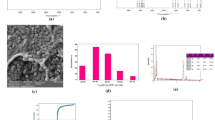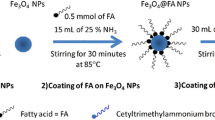Abstract
Polycyclic aromatic hydrocarbons (PAHs) are harmful to the health of people and other organisms due to their high toxicity, difficult degradation, and wide distribution. At present, the removal of PAHs from the environment is still an urgent challenge. In this study, silica-coated magnetic nanoparticles were conjugated with DNA and then used to remove 1, 2-benzoanthracene (BaA) from aqueous solution due to the intercalation between BaA and DNA. The effects of contact time, temperature, and pH on the BaA removal efficiency were evaluated; the maximum removal efficiency was obtained when BaA was incubated with DNA-conjugated magnetic nanoparticles for 40 min at 25℃ and pH 7.0. The initial volume of BaA solution and the amount of magnetic nanoparticles were also evaluated. The adsorption process accorded with Langmuir model and pseudo-2nd-order kinetic model. The BaA removal efficiency was not significantly affected by co-existing ions and substances in natural water. For natural lake samples containing BaA, the removal efficiency was above 98.9% when the BaA initial concentration was in the range of 0.10–0.35 mg/L. With the advantages of excellent adsorption performance, simple operation, and high selectivity, the DNA-conjugated magnetic nanoparticles have great potential application value in water purification.








Similar content being viewed by others
Data Availability
All data generated or analyzed during this study are included in this published article.
References
Alessandrello, M. J., Tomas, M. S. J., Isaac, P., Vullo, D. L., & Ferrero, M. A. (2017). PAH removal by immobilized bacterial cells-support systems using low-cost culture media for biomass production. International Biodeterioration & Biodegradation, 120, 6–14. https://doi.org/10.1016/j.ibiod.2017.01.038
Alessandro, D. S. (2017). Factors affecting sorption of organic compounds in natural sorbent/water systems and sorption coefficients for selected pollutants: A review. Journal of Physical and Chemical Refer Data, 30(1), 187–439. https://doi.org/10.1063/1.1347984
Arfsten, D. P., Schaeffer, D. J., & Mulveny, D. C. (1996). The effects of near ultraviolet radiation on the toxic effects of polycyclic aromatic hydrocarbons in animals and plants: A review. Ecotoxicology and Environmental Safety, 33, 1–24. https://doi.org/10.1006/eesa.1996.0001
Bai, Y. L., Roncancio, D., Suo, Y. J., Shao, Y., Zhang, D. L., & Zhao, C. Y. (2019). A method based on amino-modified magnetic nanoparticles to extract DNA for PCR-based analysis. Colloids and Surfaces b: Biointerfaces, 179(20), 87–93. https://doi.org/10.1016/j.colsurfb.2019.03.005
Bowers, A.N. (2019). In situ formed magnetic ionic liquids: DNA extraction performance and fluorescence-compatibility in bioanalytical applications, Iowa State University, 2019, M.S.
Çelebi, H., Gök, O., & Sponza, D. T. (2016). Removals of non-analogous OTC and BaP in AMCBR with and without primary substrate. Environmental Technology, 37(14), 1768–1781. https://doi.org/10.1080/09593330.2015.1131752
Clercq, N. D., Vlaemynck, G., Pamel, E. V., Weyenberg, S. V., Herman, L., Devlieghere, F., Meulenaer, B. D., & Coillie, E. V. (2016). Isoepoxydon dehydrogenase (idh) gene expression in relation to patulin production by Penicillium expansum under different temperature and atmosphere. International Journal of Food Microbiology, 220, 50–57. https://doi.org/10.1016/j.ijfoodmicro.2016.01.004
David, B. (2009). Sonochemical degradation of PAH in aqueous solution. Part I: Monocomponent PAH solution. Ultrasonics Sonochemistry, 16, 260–265. https://doi.org/10.1016/j.ultsonch.2008.07.013
Ekanayake, D., Loganathan, P., Johir, M. A. H., Kandasamy, J., & Vigneswaran, S. (2021). Enhanced removal of nutrients, heavy metals, and sAH from synthetic stormwater by incorporating different adsorbents into a filter media. Water Air Soil Pollution, 232, 96–108. https://doi.org/10.1007/s11270-021-05059-6
Fakhradini, S. S., Moore, F., Keshavarzi, B., & Lahijanzadeh, A. (2019). Polycyclic aromatic hydrocarbons (PAHs) in water and sediment of Hoor Al-Azim wetland, Iran: A focus on source apportionment, environmental risk assessment, and sediment-water partitioning. Environmental Monittoringand Assessment, 191, 233–251. https://doi.org/10.1007/s10661-019-7360-0
Georgopoulou, M. P., & Chrysikopoulos, C. V. (2018). Evaluation of carbon nanotubes and quartz sand for the removal of formaldehyde-(2, 4-dinitrophenylhydrazine) from aqueous solutions. Industrial & Engineering Chemistry Research, 57(49), 17003–17012. https://doi.org/10.1021/acs.iecr.8b03996
Gong, J. L., Wang, B., & Zeng, G. M. (2009). Removal of cationic dyes from aqueous solution using magnetic multi-wall carbon nanotube nanocomposite as adsorbent. Journal of Hazardous Materials., 164(2–3), 1517–1522. https://doi.org/10.1016/j.jhazmat.2008.09.072
Gong, C. H., Huang, H. O., Qian, Y., Zhang, Z. G., & Wu, H. B. (2017). Integrated electrocoagulation and membrane filtration for PAH removal from realistic industrial wastewater: Effectiveness and mechanisms. The Royal Society of Chemistry, 7, 52366–52374. https://doi.org/10.1039/c7ra09372a
Grueso, E., Cerrillos, C., & Hidalgo, J. (2012). Compaction and decompaction of DNA induced by the cationic surfactant CTAB. Langmuir, 28(30), 10968–10979. https://doi.org/10.1021/la302373m
Han, X. K., Wang, F. W., Zhang, D. J., Feng, T., & Zhang, L. L. (2021). Nitrate-assisted biodegradation of polycyclic aromatic hydrocarbons (PAHs) in the water-level-fluctuation zone of the three Gorges Reservoir, China: Insights from in situ microbial interaction analyses and a microcosmic experiment. Environmental Pollution, 268, 115693. https://doi.org/10.1016/j.envpol.2020.115693
Hao, S., Zheng, X. L., Zhou, Z. X., He, W. T., Li, M. Q., Su, P., Song, J. Y., & Yang, Y. (2020). Oriented immobilization of enzyme-DNA conjugates on magnetic Janus particles for constructing a multi compartment multi enzyme system with high activity and stability. Journal of Materials Chemistry B, 8(36), 8467–8475. https://doi.org/10.1039/D0TB01439G
HJ478–2009. China’s environmental protection standard: Water quality -Determination of polycyclic aromatic hydrocarbons by liquid-liquid extraction and solid-phase extraction-High performance liquid chromatography (S)
Ho, Y. S. (2006). Review of second-order models for adsorption systems. Journal of Hazardous Materials., 136(3), 681–689. https://doi.org/10.1016/j.jhazmat.2005.12.043
Huang, Y. Z., Sui, Q., Wang, J. Q., Huang, S. X., Zhao, W. T., Wang, B., & Kong, M. (2020). Tracking emission sources of PAHs in a region with pollution-intensive industries, Taihu Basin: From potential pollution sources to surface. Environmental Pollution, 264, 114674–1114685. https://doi.org/10.1016/j.envpol.2020.114674
Huang, G. X., Ma, J., Li, J. S., & Yan, L. J. (2021). Removal of 1, 2-benzanthracene via the intercalated combination of 1, 2-benzanthracene with hsDNA and magnetic bead-based separation. Nucleosides Nucleotides & Nucleosides, 40(2), 137–156. https://doi.org/10.1080/15257770.2020.1839905
Khan, S., Waqas, M., Ding, F., Shamshad, I., Arp, H. P. H., & Li, G. (2015). The influence of various biochars on the bioaccessibility and bioaccumulation of PAHs and potentially toxic elements to turnips (Brassica rapa L.). Journal of Hazardous Materials, 300, 243–253. https://doi.org/10.1016/j.jhazmat.2015.06.050
Li, X. L., Lu, H. J., & Zhang, Y. (2016). Fabrication of magnetic alginate beads with uniform dispersion of CoFe2O4 by the polydopamine surface functionalization for organic pollutants removal. Applied Surface Science, 389, 567–577. https://doi.org/10.1016/j.apsusc.2016.07.162
Liu, Y. C., Wang, X. Q., & Wu, H. (2017). Reusable DNA-conjugated-graphene for ultrasensitive mercury (II) detection and removal. Biosensors and Bioelectronics, 87, 129–135. https://doi.org/10.1016/j.bios.2016.07.059
Manariotis, I. D., Karapanagioti, H. K., & ChrysikopoulosC, V. (2011). Degradation of PAHs by high frequency ultrasound. Water Research, 45, 2587–2594. https://doi.org/10.1016/j.watres.2011.02.009
May, C. C. (2005). Development of an automated DNA extraction protocol utilizing magnetic beads for high-throughput processing of a range of biological material, Trent University, Canada, M.Sc.
Mondal, M. H., Malik, S., & Saha, B. (2017). Characterization of pyrene solubilization in selective micellar media of novel bio-degradable natural surfactant saponin (extracted from soap nut) and conventional surfactant SDBS in presence and absence of common salt NaCl. Tenside Surfactants Detergents, 54(5), 378–384. https://doi.org/10.3139/113.110519
Mortazavi, M., Baghdadi, M., SeyedJavadi, N. H., & Torabian, A. (2019). The black beads produced by simultaneous thermal reducing and chemical bonding of graphene oxide on the surface of amino-conjugated sand particles: Application for PAHs removal from contaminated waters. Journal of Water Process Engineering, 31, 100798–100811. https://doi.org/10.1016/j.jwpe.2019.100798
Nikolaou, A., Kostopoulou, M., Petsas, A., Vagi, M., Lofrano, G., & Meric, S. (2009). Levels and toxicity of polycyclic aromatic hydrocarbons in marine sediments. Trac-Trends in Analytical Chemistry, 28(6), 653–664. https://doi.org/10.1016/j.trac.2009.04.004
Nowacka, A., & Makuła, M. W. (2015). Effectiveness of priority PAH removal in a water coagulation process. Water Supply, 15(4), 683–692. https://doi.org/10.2166/ws.2015.023
Petry, T., Schmid, P., & Schlater, C. (1996). The use of toxic equivalency factors in assessing occupational and environmental health risk associated with exposure to airborne mixtures of polycyclic aromatic hydrocarbons (PAHs). Chemosphere, 32, 639–648. https://doi.org/10.1016/0045-6535(95)00348-7
Prodelalova, J., Rittich, B., Spanova, A., Petrova, K., & Benes, M. J. (2004). Isolation of genomic DNA using magnetic cobalt ferrite and silica particles. Journal of Chromatography a., 1056, 43–48. https://doi.org/10.1016/S0021-9673(04)01448-7
Song, T. T., Tian, W. J., Zhao, J., Qiao, K. L., Zou, M. Y., & Chu, M. L. (2021). N-doped reduced graphene oxide nanocomposites encapsulated sodium alginate/polyvinyl alcohol microspheres for anthracene and its oxygenated-PAH removal in aqueous solution. Journal of the Taiwan Institute of Chemical Engineers, 125, 168–175. https://doi.org/10.1016/j.jtice.2021.06.016
Stefanarou, A. S., & Chrysikopoulos, C. V. (2021). Interaction of titanium dioxide with formaldehyde in the presence of quartz sand under static and dynamic conditions. Water, 13, 1420. https://doi.org/10.3390/w13101420
Torabian, A., Panahi, H. A., Hendi, G. R. N. B., & Mehrdadi, N. (2014). synthesis, modification and graft polymerization of magnetic nanoparticles for PAH removal in contaminated water. Journal of Environmental Health Science & Engineering, 12, 105–114.
Torretta, V. (2018). Removal efficiency of PAHs in wastewater: Statistical evaluations with chemical-physical indicators. Environmental Engineering and Management Journal, 17(2), 251–259.
Tyson, C. D. (2016). Development and Use of novel transverse magnetic tweezers for single-molecule studies of DNA-protein interactions. The Catholic University of America, Ph.D
Wickramasinghe, A. D. L., & Shukla, S. P. (2018). Performance evaluation of a pellet based column bed for removal of a potentially carcinogenic polycyclic aromatic hydrocarbon (PAH) from water. Journal of Environmental Chemical Engineering, 6, 6012–6020. https://doi.org/10.1016/j.jece.2018.09.009
Xu, L., Feng, L., & Hao, J. (2015). Compaction and decompaction of DNA dominated by the competition between counterions and DNA associating with cationic aggregates. Colloid Surface B, 134, 105–112. https://doi.org/10.1016/j.colsurfb.2015.06.038
Yang, R., Li, D. W., & Li, A. M. (2018). Adsorption properties and mechanisms of palygorskite for removal of various ionic dyes from water. Application Clay Science, 151, 20–28. https://doi.org/10.1016/j.clay.2017.10.016
Zanato, A. F. S., Silva, V. C., Lima, D. A., & Jacinto, M. J. (2017). Bimetallic magnetic PtPd-nanoparticles as efficient catalyst for PAH removal from liquid media. Applied Nanoscience, 7, 781–791. https://doi.org/10.1007/s13204-017-0612-9
Zhang, W., Wei, C. H., Chai, X. S., He, J. Y., Cai, Y., Ren, M., Yan, B., Peng, P. G., & Fu, J. M. (2012). The behaviors and fate of polycyclic aromatic hydrocarbons (PAHs) in a coking wastewater treatment plant. Chemosphere, 88, 174–182. https://doi.org/10.1016/j.chemosphere.2012.02.076
Zhang, C., Liu, W. J., Wang, T. Y., Qian, T. T., Ain, N. U., Wu, L. Q., Wu, X. N., Cai, X. P., Zeng, Q., & Xie, H. P. (2020). Fabrication of surface charge pH-sensitive multi-bumpy small magnetic bead with ultrahigh magnetic content and its ultrahigh loading capacity and salt-free rapid isolation for DNA. Journal of Pharmaceutical and Biomedical Analysis, 189, 113439. https://doi.org/10.1016/j.jpba.2020.113439
Zhao, W. T., Sui, Q., & Huang, X. (2018). Removal and fate of polycyclic aromatic hydrocarbons in a hybrid anaerobic-anoxic-oxic process for highly toxic coke wastewater treatment. Science of theTotalEnvironment, 635, 716–724. https://doi.org/10.1016/j.scitotenv.2018.04.162
Zhu, C. H. (2020). Magnetic ionic liquids in applications of nucleic acid analysis: Sequence-specific extraction of DNA and preservation solvents of RNA. Iowa State University.
Funding
This work was supported by the National Natural Science Foundation of China under Grant 21966008. This work was also supported by the Guangxi Natural Science Foundation of China under Grant 2018GXNSFDA281030 and 2020GXNSFAA159021.
Author information
Authors and Affiliations
Contributions
Guoxia Huang: conceptualization, methodology, formal analysis, writing—original draft, data curation, and funding acquisition. Junsheng Li: visualization, supervision, and funding acquisition. Liujuan Yan: methodology, review, and editing. Ji Ma: software, review, and editing.
Corresponding author
Ethics declarations
Conflict of Interest
The authors declare no competing interests.
Additional information
Publisher's Note
Springer Nature remains neutral with regard to jurisdictional claims in published maps and institutional affiliations.
Rights and permissions
About this article
Cite this article
Huang, G., Li, J., Yan, L. et al. Adsorption of 1, 2-Benzanthracene from Aqueous Solution by DNA-Conjugated Magnetic Nanoparticles. Water Air Soil Pollut 233, 9 (2022). https://doi.org/10.1007/s11270-021-05476-7
Received:
Accepted:
Published:
DOI: https://doi.org/10.1007/s11270-021-05476-7




